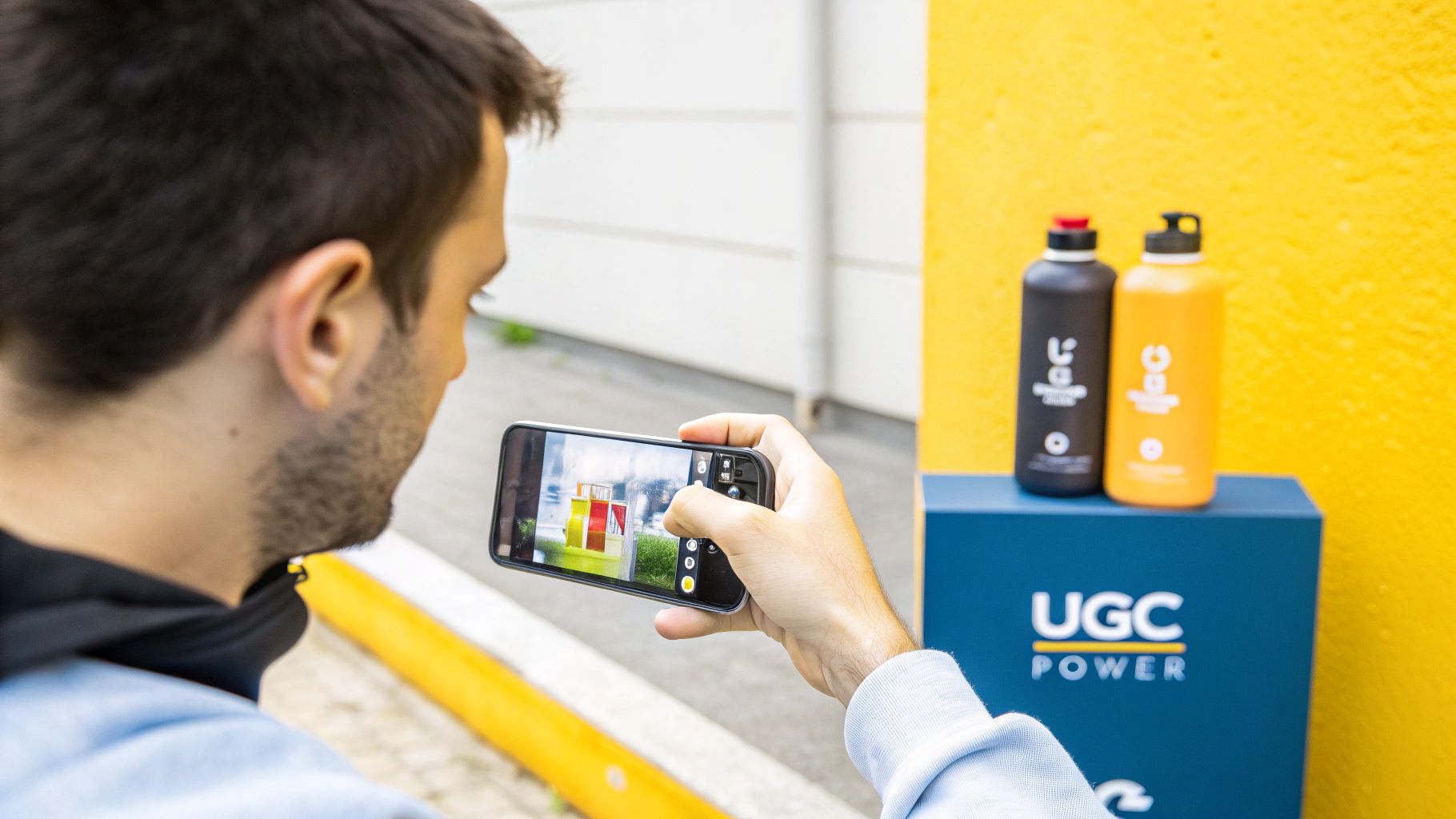Top Social Media Engagement Strategies for 2025

In the crowded digital landscape, likes and follower counts are no longer the ultimate measure of success. True growth and brand loyalty are built on meaningful interactions. But how do you cut through the noise and foster genuine connections? The answer lies in deploying smart, effective social media engagement strategies that transform passive followers into an active, invested community. A high follower count is a vanity metric if those followers don't interact, share, or advocate for your brand. Authentic engagement, on the other hand, signals a healthy, thriving community that trusts your message and values your presence.
This comprehensive guide moves beyond generic advice to provide a deep dive into 10 proven strategies that drive real results. We will explore actionable tactics designed for modern audiences, from leveraging user-generated content and implementing sophisticated social listening to building vibrant communities and launching effective employee advocacy programs. Each point is packed with real-world examples, specific implementation details, and key performance indicators to track your success.
Whether you're a startup CTO seeking to build a brand from scratch, a marketing team looking to enhance digital outreach, or an enterprise aiming to deepen customer relationships, this listicle provides the blueprint. You will learn how to:
- Turn followers into brand advocates.
- Create content that sparks conversations, not just views.
- Build a loyal community that drives tangible business outcomes.
These social media engagement strategies are designed to be both platform-agnostic and platform-specific, giving you a versatile toolkit to create a vibrant, engaged, and powerful online presence that contributes directly to your bottom line. Let's dive into the tactics that will redefine your approach to social media.
1. User-Generated Content (UGC) Strategy
A User-Generated Content (UGC) strategy transforms your audience from passive consumers into active brand advocates. It involves encouraging, collecting, and sharing content created by your customers, such as photos, videos, reviews, and testimonials. This approach is one of the most powerful social media engagement strategies because it builds immense trust through authentic social proof, fostering a vibrant community around your brand.

When potential customers see real people enjoying your products or services, it resonates more deeply than traditional advertising. This authenticity is key to cutting through the noise on social media and driving genuine connection. UGC effectively outsources content creation to your most passionate fans, providing a steady stream of material that is both cost-effective and highly persuasive.
How to Implement a UGC Strategy
A successful UGC campaign is more than just waiting for customers to post. It requires a clear and proactive plan.
- Create a Memorable Branded Hashtag: Develop a unique, short, and easy-to-remember hashtag for your campaign. This centralizes submissions and makes it easy to track content. For example, Apple's iconic #ShotOniPhone campaign brilliantly showcases the quality of its camera through the eyes of its users.
- Set Clear Guidelines and Incentives: Tell your audience exactly what kind of content you're looking for. Offer incentives like a chance to be featured on your official page, discounts, or prizes. Starbucks' "White Cup Contest" generated over 4,000 designs by offering a prize for the best one.
- Engage and Give Credit: Always ask for permission before reposting a user's content and be sure to credit them by tagging their profile in the post and caption. Publicly thank contributors to encourage further participation and show your appreciation.
This strategy is highly effective for B2C brands in industries like fashion, travel, food, and tech, where visual content is paramount. It works best when you have an established and enthusiastic customer base ready to share their experiences. By leveraging UGC, you not only boost engagement but also build a powerful library of authentic marketing assets. Exploring more advanced content marketing techniques can help you integrate UGC into a broader, more impactful strategy.
2. Social Listening and Real-Time Engagement
Social listening and real-time engagement is a proactive strategy that moves beyond simply posting content. It involves actively monitoring social media for mentions of your brand, competitors, and industry keywords, then strategically engaging in those conversations as they happen. This approach positions your brand as responsive, relevant, and deeply connected to your audience's needs and interests.

By tuning into the digital chatter, you can address customer service issues before they escalate, identify emerging trends, and find authentic opportunities to join popular discussions. This is one of the most dynamic social media engagement strategies because it allows you to demonstrate personality, provide immediate value, and humanize your brand in a way that scheduled content cannot.
How to Implement Social Listening and Real-Time Engagement
Effective real-time engagement requires preparation and the right tools. It's about being ready to act on opportunities thoughtfully and quickly.
- Utilize Social Listening Tools: Employ platforms like Hootsuite, Sprout Social, or Brandwatch to track conversations. Set up alerts for your brand name (including common misspellings), key products, executive names, and industry-specific hashtags to ensure you never miss a relevant mention.
- Establish Clear Protocols: Define your brand's voice and create response templates for common inquiries to maintain consistency. Establish clear escalation procedures for sensitive issues and set internal goals for response times, aiming for under an hour for urgent matters to meet customer expectations.
- Engage Authentically and Strategically: Train your team to identify which trending conversations are relevant to your brand. A prime example is Oreo's famous "You can still dunk in the dark" tweet during the 2013 Super Bowl blackout, a perfect blend of timing, relevance, and brand voice that went viral.
This strategy is crucial for virtually any business, but especially for service-oriented B2C and B2B brands that rely on customer satisfaction and brand reputation. It thrives in fast-paced environments where quick, clever, or helpful responses, like those famously used by Wendy's and JetBlue on Twitter, can significantly boost visibility and build brand loyalty.
3. Influencer Collaboration and Partnership
An Influencer Collaboration and Partnership strategy leverages the credibility and reach of established social media creators to promote your brand. This involves partnering with individuals who have built engaged communities in specific niches, allowing you to tap into their trusted voice and authentic connection with their audience. This approach is one of the most effective social media engagement strategies for reaching new, targeted demographics and generating powerful social proof.

When an influencer shares your product, their recommendation acts as a warm introduction, bypassing the skepticism often associated with traditional ads. This method has evolved beyond celebrity endorsements to include micro and nano-influencers, who often deliver higher engagement rates within hyper-specific communities. This authenticity is crucial for building brand affinity and driving conversions in a crowded digital landscape.
How to Implement an Influencer Collaboration Strategy
A successful influencer partnership requires careful planning, vetting, and clear communication to ensure brand alignment and measurable results.
- Prioritize Alignment and Authenticity: Look beyond follower count and focus on an influencer's engagement rate and brand fit. Vet potential partners thoroughly to ensure their values, content style, and audience demographics align with your brand. Daniel Wellington’s early success was built on gifting watches to thousands of micro-influencers, creating a groundswell of authentic-looking posts.
- Provide Clear Guidelines with Creative Freedom: Give influencers a clear brief with key messaging and campaign goals, but allow them the creative freedom to produce content in their unique voice. This balance ensures the content feels genuine to their audience, not like a forced advertisement. Dunkin's partnership with Charli D'Amelio on TikTok is a prime example of leveraging a creator's natural style to reach a new generation.
- Track Performance and Build Relationships: Use trackable links or unique discount codes to measure the ROI of each collaboration. Focus on building long-term relationships with high-performing influencers, turning one-off posts into sustained brand ambassadorships that provide ongoing value.
This strategy is highly effective for brands in visually driven industries like fashion, beauty, fitness, and food, but can be adapted for SaaS and tech. It works best when you aim to build credibility, reach a niche audience quickly, and drive direct sales through trusted recommendations. By collaborating with the right influencers, you can significantly boost brand awareness and engagement.
4. Interactive Content and Polls
An interactive content strategy moves your audience from passive consumption to active participation. It involves using engaging formats like polls, quizzes, surveys, and Q&A sessions to invite followers to share their opinions and co-create the conversation. This approach is one of the most effective social media engagement strategies because it makes followers feel heard and valued, transforming your feed into a two-way dialogue rather than a one-way broadcast.

When users participate, it signals to platform algorithms that your content is valuable, boosting its visibility. More importantly, interactive content provides direct, real-time feedback and data about your audience's preferences, pain points, and interests. This approach not only increases engagement metrics but also strengthens the brand-audience relationship by fostering a sense of community and involvement.
How to Implement Interactive Content
A successful interactive content plan requires more than just asking random questions; it needs a clear purpose and a creative approach.
- Ask Relevant, Engaging Questions: Frame your polls and quizzes around topics that genuinely matter to your audience. Netflix frequently uses Twitter polls to let fans debate plot points or choose which content to see next, making viewers feel involved in the brand's decisions.
- Keep it Simple and Fun: Make participation easy. Polls should have just 2-4 clear options. BuzzFeed perfected this with its viral quizzes, using humor and personality to drive millions of social shares by helping people discover "Which Disney Princess Are You?".
- Share and Act on the Results: Always follow up by sharing the results of your polls and surveys. Explain what you learned and how it will influence future content or product decisions. This closes the feedback loop and shows your audience that their input has a real impact.
This strategy is highly versatile and works for both B2B and B2C brands across nearly all industries. It is particularly effective for gathering market research, informing content strategy, or simply boosting community interaction. By making your audience part of the conversation, you build a loyal following that is invested in your brand's journey and eager to engage with future content.
5. Video Content Strategy (Short and Long-Form)
A Video Content Strategy leverages the most dominant medium on social media to capture attention and drive interaction. This approach involves creating both short-form videos (Reels, TikToks, Shorts) for quick, viral engagement and long-form content (YouTube, IGTV) for deeper storytelling and value. As algorithms increasingly prioritize video, a well-rounded strategy is one of the most essential social media engagement strategies for modern brands.
Video combines visual and auditory elements to create a powerful, emotional connection that static images or text cannot replicate. It allows you to showcase brand personality, demonstrate product value, and entertain your audience in a highly shareable format. From Duolingo’s unhinged and viral TikToks to Red Bull’s high-octane long-form documentaries, video offers a versatile canvas for engagement.
How to Implement a Video Content Strategy
A successful video strategy requires a balanced approach to both short and long-form content, tailored to specific platform dynamics.
- Hook Viewers Immediately: The first three seconds are critical. Start with a strong visual hook, a provocative question, or a surprising statement to stop users from scrolling. Tasty's recipe videos master this by showing the delicious final product first.
- Optimize for Silent, Vertical Viewing: Design your videos for mobile-first consumption. Use a vertical format (9:16 aspect ratio) and add clear, easy-to-read captions, as a majority of users watch videos with the sound off.
- Repurpose Content Intelligently: Create one pillar piece of long-form content, like a YouTube tutorial or a webinar, and slice it into multiple short-form clips. Gary Vaynerchuk is a master of this, turning one keynote speech into dozens of shareable social media moments.
This strategy is effective for virtually any industry, from B2B tech explaining complex services to B2C e-commerce showcasing products in action. It works best when you have a clear plan for both creating original content and repurposing it across channels to maximize reach and efficiency. Developing diverse social media content ideas will ensure your video feed remains fresh and engaging.
6. Community Building and Social Groups
A community-building strategy shifts your focus from broadcasting one-way messages to fostering a dedicated, interactive space for your audience. It involves creating environments like Facebook Groups, Discord servers, or branded forums where customers can connect with each other and your brand on a deeper level. This is one of the most sustainable social media engagement strategies because it cultivates a sense of belonging and transforms passive followers into a loyal, interconnected community.
Instead of just selling to an audience, you are facilitating peer-to-peer conversations and shared experiences. This approach builds powerful brand loyalty, as members feel they are part of an exclusive group with shared values. The genuine interactions within these communities create a powerful moat around your brand, making it much harder for competitors to poach your customers.
How to Implement a Community-Building Strategy
Building a thriving community requires active participation and a clear framework. You must be a host, not just a moderator.
- Establish Clear Guidelines and Purpose: From day one, set the rules of engagement and the community’s mission. This ensures conversations stay positive, on-topic, and valuable. A strong foundation prevents spam and conflict, creating a safe space for members.
- Provide Exclusive Value and Foster Discussion: Offer content, events, or early access that members can't get anywhere else. Actively start conversations by asking open-ended questions and encouraging members to share their own experiences. Peloton excels at this, creating Facebook groups where over 400,000 members share fitness journeys and motivate one another.
- Recognize and Empower Super-Users: Identify your most active members and reward their contributions. You can feature them in a "member spotlight," give them special titles, or even invite them to become community moderators or ambassadors. This validates their participation and encourages others to engage more deeply.
This strategy is ideal for brands with a strong mission, a specific lifestyle niche, or a complex product that benefits from user collaboration, such as SaaS, fitness, beauty, and hobby-focused industries. It works best when you are committed to long-term relationship building rather than short-term wins. For a deeper dive into cultivating a loyal audience, explore this definitive guide to building an online community.
7. Storytelling and Behind-the-Scenes Content
A Storytelling and Behind-the-Scenes (BTS) strategy humanizes your brand by pulling back the curtain and revealing the people, processes, and values that define your company. This approach moves beyond polished marketing messages to share authentic narratives, company culture, product development journeys, and team member spotlights. It is a vital social media engagement strategy for building transparency, trust, and a deep emotional connection with your audience.
When followers get an insider’s view, they feel more connected and invested in your brand’s journey. This transparency fosters a loyal community that is engaged not just with what you sell, but with who you are and what you stand for. Sharing stories transforms abstract brand values into relatable, compelling narratives that resonate on a personal level and differentiate you from competitors.
How to Implement a Storytelling and BTS Strategy
Effectively sharing your brand’s story requires more than just random snapshots of your office. It demands a thoughtful and consistent narrative approach.
- Showcase the Process, Not Just the Product: Take your audience on a journey from idea to execution. Warby Parker masterfully shares its origin story and social mission, connecting customers to its purpose. Similarly, Tesla provides factory tours and product development updates that make customers feel like insiders.
- Feature Your People and Values: Spotlight the employees who make your brand what it is. Ben & Jerry’s effectively ties its products to its long-standing commitment to social justice, sharing stories that reflect its core values and energize its community.
- Embrace Imperfection and Authenticity: Use ephemeral formats like Instagram and Facebook Stories for raw, unpolished glimpses into daily operations. Share both the successes and the challenges to build credibility. Authenticity often matters more than perfection in building genuine relationships.
This strategy is highly effective for mission-driven brands, startups, and companies with a unique production process or compelling company culture. It works best when you want to build a lasting emotional bond with your audience, turning customers into advocates. By weaving compelling stories and sharing authentic BTS moments, you create a powerful narrative that drives loyalty and engagement.
8. Consistent Posting Schedule and Content Calendar
A consistent posting schedule, organized through a content calendar, is the backbone of any successful social media presence. This strategy involves planning, creating, and scheduling content in advance, ensuring a steady stream of valuable posts for your audience. It transforms your social media from a reactive, chaotic task into a proactive, strategic operation, making it one of the most fundamental social media engagement strategies for building a reliable brand presence.
When your audience knows when to expect content from you, they are more likely to look for it and engage with it. This predictability builds trust and keeps your brand top-of-mind. A content calendar allows you to strategically balance different types of posts, such as educational, entertaining, and promotional content, preventing audience fatigue and maximizing value. This disciplined approach ensures you never miss an opportunity to connect with your followers.
How to Implement a Content Calendar Strategy
Building an effective posting schedule requires more than just filling slots; it involves thoughtful planning and analysis.
- Establish Content Pillars and Follow the 80/20 Rule: Define 3-5 core themes (pillars) your content will focus on. Adhere to the 80/20 rule: 80% of your content should provide value (educate, entertain, inspire), while only 20% should be directly promotional. Buffer exemplifies this by sharing a mix of industry insights, user tips, and transparent company updates.
- Identify Peak Engagement Times: Use the native analytics on each social media platform to discover when your specific audience is most active. Schedule your most important content to go live during these peak windows to maximize reach and initial engagement.
- Use Scheduling Tools and Batch Content: Leverage tools like Buffer, Hootsuite, or Later to schedule posts in advance. Batch-create your content, dedicating specific blocks of time to write captions, design graphics, and edit videos for the upcoming week or month. This saves time and reduces the pressure of daily content creation.
This strategy is universally effective for B2B and B2C brands across all industries. It is particularly crucial for businesses aiming to establish authority, generate consistent leads, and build a loyal community over time. Integrating your social media schedule into a comprehensive digital marketing plan template ensures all your outreach efforts are aligned for maximum impact.
9. Social Commerce and Shoppable Posts
A Social Commerce strategy integrates the point of sale directly into social media platforms, transforming your feed into an interactive storefront. It involves using features like Instagram Shopping, Facebook Shops, and Pinterest Product Pins to tag products in posts, allowing users to browse and purchase without ever leaving the app. This is one of the most effective social media engagement strategies because it drastically reduces friction in the buying process, converting discovery and inspiration into sales almost instantly.
By merging content, community, and commerce, you create a seamless journey from interest to purchase. When a user sees a product they love in a lifestyle photo or video, they can tap to see the price and proceed to checkout in a few clicks. This immediacy capitalizes on the impulse-driven nature of social media browsing, turning passive scrolling into an active shopping experience and boosting conversion rates.
How to Implement a Social Commerce Strategy
A successful social commerce plan requires more than just enabling shopping features; it needs a content-driven approach to entice buyers.
- Create High-Quality, Contextual Content: Showcase your products in real-life settings, not just on a white background. Use lifestyle photos and videos to help customers visualize how the product fits into their lives. For example, Target excels by creating shoppable Instagram posts that feature their home decor items in beautifully styled rooms.
- Tag Products Seamlessly: Integrate product tags naturally within your content. Tag multiple items in a lookbook-style post or highlight a single product in an Instagram Story. The goal is to make shopping an organic part of the content experience, not an intrusive sales pitch.
- Leverage Live Shopping Events: Host live streams on platforms like Instagram or Amazon Live to demonstrate products, answer questions in real-time, and offer exclusive, time-sensitive discounts. This creates urgency and fosters a direct, interactive connection with your audience.
This strategy is exceptionally powerful for B2C brands in sectors like fashion, beauty, home goods, and consumer electronics, where visual appeal drives purchasing decisions. It thrives when you can present products in an aspirational yet relatable way. By integrating social commerce, you not only increase sales but also gather valuable data on which products and content styles resonate most with your audience. You can further refine your approach by exploring more advanced social media monetization strategies to maximize your return.
10. Employee Advocacy and Brand Ambassador Programs
An Employee Advocacy and Brand Ambassador Program is a strategy that mobilizes your internal team and most loyal customers to become powerful brand champions. It involves formally encouraging and empowering them to share positive, authentic content about your brand on their personal social media profiles. This approach is one of the most effective social media engagement strategies for building trust, as messages from individuals are inherently more credible than those from official corporate accounts.
This strategy humanizes your brand by putting real faces and voices at the forefront of your marketing efforts. Content shared by employees often receives significantly higher engagement rates and extends your reach far beyond your existing follower base. By tapping into the collective networks of your team, you can amplify your message authentically and cost-effectively, turning your employees into a trusted marketing force.
How to Implement an Employee Advocacy Program
A successful program requires structure, clear communication, and genuine enthusiasm, not forced participation.
- Provide Resources, Not Scripts: Equip your advocates with a library of pre-approved content, brand assets, and key messaging points. Tools like EveryoneSocial or Bambu can centralize this content, but always encourage employees to add their own personal touch to posts to maintain authenticity.
- Offer Training and Clear Guidelines: Many employees may want to participate but aren't sure how. Host workshops on social media best practices and provide clear guidelines on what is appropriate to share, including disclosure policies. Dell’s Social Media and Communities University is a prime example of training employees to be effective brand ambassadors.
- Recognize and Reward Participation: Make participation voluntary and rewarding. Publicly recognize top-performing advocates, feature their content, and consider gamification elements like leaderboards or small incentives. This fosters a positive and encouraging environment. Salesforce, for example, successfully engages over 40,000 employees in its program by celebrating their contributions.
This strategy is highly effective for B2B and B2C companies alike, especially those with a strong company culture and an engaged workforce. It works best when you prioritize authenticity over control, empowering your team to share their genuine passion for the brand. When executed properly, employee advocacy can dramatically boost your credibility and social media engagement.
Social Media Engagement Strategies Comparison
| Strategy | Implementation Complexity 🔄 | Resource Requirements ⚡ | Expected Outcomes 📊 | Ideal Use Cases 💡 | Key Advantages ⭐ |
|---|---|---|---|---|---|
| User-Generated Content (UGC) Strategy | Medium (moderation & incentives) | Low to Medium (community mgmt) | Increased trust, engagement, conversions | Brands seeking authentic social proof | Cost-effective, builds trust & emotional connection |
| Social Listening and Real-Time Engagement | High (continuous monitoring) | High (tools + dedicated team) | Stronger relationships, crisis management | Brands needing rapid response & market insights | Quick crisis control, valuable market insights |
| Influencer Collaboration and Partnership | Medium to High (finding & managing) | Medium to High (budgets + vetting) | Access to targeted, engaged audiences | Brands targeting niche demographics | High engagement, credible endorsements |
| Interactive Content and Polls | Low to Medium (content creation) | Low (platform tools) | Higher engagement, audience insights | Brands aiming to boost engagement & gather feedback | Easy implementation, valuable insights |
| Video Content Strategy (Short & Long) | High (production, editing skills) | High (equipment, editing, talent) | Higher views, retention, emotional impact | Brands focusing on storytelling & visual engagement | Favored by algorithms, versatile content formats |
| Community Building and Social Groups | High (moderation & consistent activity) | Medium to High (management & events) | Strong brand loyalty, peer support | Brands building long-term loyal communities | Creates belonging, reduces service load |
| Storytelling and Behind-the-Scenes Content | Medium (content planning & transparency) | Medium (creative resources) | Authentic connections, emotional investment | Brands wanting transparency & relatability | Builds trust, differentiates brand |
| Consistent Posting Schedule & Calendar | Medium (planning & scheduling) | Medium (tools & team coordination) | Steady brand presence, reduced content stress | Brands requiring regular presence & strategy | Improves quality, aligns with goals |
| Social Commerce and Shoppable Posts | High (technical integration) | Medium to High (setup, fees) | Higher conversions, seamless buying | Visual product brands focused on impulse sales | Reduces purchase friction, leverages social platforms |
| Employee Advocacy and Brand Ambassador Programs | Medium (training & incentives) | Medium (content curation & support) | Extended reach, higher engagement | Companies enhancing internal brand promotion | Builds trust, cost-effective amplification |
Putting Your Engagement Blueprint into Action
The journey through these ten distinct social media engagement strategies reveals a powerful, unifying truth: engagement is not a singular act but a sustained, multifaceted conversation. It’s the difference between shouting into a void and building a vibrant, interactive community. We’ve explored the authentic power of user-generated content, the proactive necessity of social listening, and the compelling draw of video in all its forms. From fostering dedicated communities in social groups to showcasing your brand’s human side with behind-the-scenes storytelling, each tactic serves as a vital component in a much larger machine.
The ultimate goal is to transition your social media presence from a simple broadcast channel into a dynamic ecosystem where your audience feels seen, heard, and valued. This is how you transform passive followers into passionate brand advocates.
From Blueprint to Reality: Your Actionable Next Steps
Mastering this long list of social media engagement strategies can feel daunting. The key is not to implement everything at once, but to build a strategic, scalable plan. Here’s how to move forward effectively:
Audit and Prioritize: Begin by evaluating your current resources, team capabilities, and audience behavior. Which of these strategies aligns most naturally with your brand voice and business goals? A B2B tech firm might prioritize employee advocacy and long-form video, while a B2C fashion brand could focus on UGC, influencer collaborations, and social commerce.
Select Your "Power Trio": Choose two or three strategies to master first. This focused approach prevents your team from becoming overwhelmed and allows you to dedicate the necessary resources to execute them flawlessly. For instance, you could start by building a consistent content calendar, launching an interactive poll series, and partnering with a micro-influencer.
Define Success and Set KPIs: How will you measure success? For a community-building initiative, your key performance indicator (KPI) might be the daily active user count in your Facebook Group. For a UGC campaign, it could be the number of submissions using your branded hashtag. Be specific and track your progress rigorously.
Create an Implementation Roadmap: Break down each chosen strategy into smaller, manageable tasks. Assign ownership, set deadlines, and integrate these tasks into your existing project management workflow. This ensures accountability and maintains momentum.
The True Value of a High-Engagement Strategy
Ultimately, a robust social media engagement strategy does more than just boost vanity metrics like likes and comments. It directly impacts your bottom line by building brand loyalty, generating qualified leads, and providing invaluable customer insights. When your audience is truly engaged, they become an extension of your marketing team, sharing your content, defending your brand, and providing the social proof needed to attract new customers.
While each strategy contributes to the overall goal, a holistic understanding of how to increase social media engagement from the ground up can provide a powerful foundation for your efforts. This foundational knowledge helps you connect the dots between different tactics, ensuring your approach is cohesive and strategic rather than reactive.
The digital landscape is in constant flux, but the core principles of human connection remain the same. The blueprint is now in your hands. By consistently applying these principles, listening intently to your audience, and adapting your approach with data-driven insights, you can cultivate a thriving digital community that not only supports but actively accelerates your business growth. Start small, be consistent, and never forget that behind every screen is a person waiting to connect.